Superb 1962 Morris FG lorry
Posted by Chris Graham on 3rd February 2022
Ian Shaw meets Len Wilkes and his superb 1962 Morris FG lorry with beautifully restored and painted dropside bodywork.

Len Wilkes’ 1962 Morris FG lorry resplendent in yellow – matched to the original colour.
Photography: Ian Shaw
With greater emphasis on pedestrian and cyclist blind spot vision, over the past decade we have seen an ever-increasing number of mirrors begin to sprout forth from LGV cabs. These are now even being replaced by cameras, with the familiar brace of convex glasses giving way to crab-eyes which project an image onto two A4-sized screens on the windscreen A-pillars – fine until a fuse blows. Physical views are not forgotten, however, as the latest truck cabs now sport lower door windows, seen for many years on far-Eastern, medium-weight commercials due to Japanese legislation.

Morris FG has a sufficient turn of speed for use in modern traffic.
However, the issue of forward blind spots masking pedestrians – particularly children – in urban situations, and the issue of the driver’s door having to be opened out into traffic, was addressed a long time ago. Revolutionary at the time, the clever British design was spread across a whole family of light and medium commercials, and it could yet make a comeback. As electric LCVs gather pace, the design issues involved in housing the combustion engine and transmission will recede, leaving clean-sheet cab design to repeat history.

Head-on, the outboard width of the cab is obvious.
The FG series light commercial, with its futuristic cab design, was introduced in October 1959, although not immediately using the FG nomenclature – it was in 1962 that the now familiar FG designation was introduced. This was followed by either a ‘K’ or an ‘M’ suffix to indicate the place of manufacture; ‘M vehicles were built at Adderley Park prior to the factory fire in 1962, while ‘K’ applied to a 1961 vehicle assembled at Cofton Hackett or, post-1961, examples which were produced at Bathgate. A final, two-digit number indicates the vehicle’s payload in hundredweights, such as FGK30 for a Bathgate-built 30cwt version, until 1967, when to fall in line with new Construction and Use Regulations, they were designated according to their Gross Vehicle Weight in tons. Hence 350FGs at three-and-a half tons GVW (or 345FG with reduced kerb weight due to body type since internally they were still designated by payload) through to 900FG at nine-ton gross. The latter with a full five-ton payload, which was impressive even compared to modern weight-watching 7.5-tonner standards.

The Morris showing it is no slouch on the open road.
The FG was badged as both Austin and Morris then, of course, BMC, from 1968, and finally in 1970, as just Leyland, while the BL tar-brush stroked ever wider. It’s generally documented that the ‘F’ merely stood for forward-control, although the cab type would now be considered as semi-forward control, certainly when viewed against a rear-engined VW Transporter, for example, and the ‘G’ was simply the next logical alphabetical designation after the previous FE model.
At the higher weight end of the range, the FG K100, which was later designated ‘900FG’, had a more pronounced snout nose to accommodate the straight-six diesel and a similar (but not interchangeable) design was used in the FM series, allowing the engine to be set further forward giving a true walk-thru, three-man cab. Aimed at multi-drop operators, they were only thought to have been supplied in numbers to the Post Office as chassis-cab derivatives. Beyond that, the 360 was re-badged as 350, to bring it within scope of a standard car driving licence; sub-3.5 tons, but was physically identical.

Proud owner Len Wilkes at the wheel, he loves to drive the FG on a regular basis.
Much was made of the cab design in the manufacturer’s brochure at the time, although it’s an indication of how our streets were far less busy that it highlights the lower blind spot windows usefulness in manoeuvres or when driving in fog rather than the possibility of running over pedestrians! However, with hindsight, it’s perhaps the rear of the cab that was more revolutionary than the front. and it certainly had a greater bearing on the overall design. Placing the doors in the rear corners of the cab allowed them to hinge rearward so that, once open, they didn’t project more than two inches beyond the sides of the FG’s load body.

Four speed gearbox and handbrake with typically-period fly-off style release.
Competitor’s designs during the life of the FG series took a different approach, with conventionally positioned sliding cab doors. The dangers of driving with the door open, in pre-seatbelt days was obviously not lost on the FG’s designers, and contemporary documentation hints at the possibility of sliding doors falling foul of future safety legislation. Today, of course, mandatory seatbelts mean the sight of those US-style Mercedes-Benz Vario-based UPS vans being driven with the door slid open are quite commonplace.
Further forward-thinking in the FG cab’s design was that, aside from the usual access via the engine cover inside the cab, and radiator top-up externally below the windscreen, the radiator grille and whole centre-front section could be removed to allow the engine to be extracted by trolley when more serious attention was required; a system used by a number of lorries at the time and since, as an alternative to a tilt-cab.

Aft position of door is obvious here and wheel arch outside of driving position.
In addition to the full cab design described, the FG was also produced as a ‘chassis front end’ more commonly known as a chassis cowl, with full height windscreen frame and front side windows. These were popular in walk-thru guise for bread vans, industrial laundry operators, mobile shop and ambulance applications. There was even a chassis scuttle which amounted to little more actual cab than the radiator grille and headlamps, for full coach-building possibilities.
The FG’s underpinnings were rather more conventional, and the chassis was effectively a slightly modified item from the previous generation of medium commercials. The rear-mounted, under-slung spare wheel made for a more acceptable universal positioning than it would on the ‘nearside’ bearing in mind export versions, notwithstanding the fuel tank’s position dominating this space on short wheelbase versions.

Rare period brochure shows promotion of the cab’s design.
Sharing the basic design across such a wide range of gross weights meant that the engine range had to follow suit. This was the period of transition between predominantly petrol-power, which was a hangover stemming from the need to have one fuel supply during the war years, and the downward migration of ‘heavy oil’ engines in larger lorries and plant. The FG series was offered with a range of both. Four-cylinder units of 2.2-litres in either petrol or diesel forms, started the range in the FG K30, 30cwt payload 3.5 tonnes GVW model with larger, four-pot diesels in 3.4-litre or 3.8-litre guises for the two-tonner – 4.2 tonnes GVW – accompanied by the option of a four-litre straight-six petrol. This unit was joined by a six-cylinder diesel displacing 5.1-litres in the FG K100, nominal five-tonner with payloads from 165cwt to 180cwt and gross weights of 8.4 to 9.1 tonnes, for our younger readers!

Wonderfully illustrated brochure claims only two inches of projection for door.
The greatest productivity benefit of the forward-control cab design lies in the high ratio of load body length to overall length. The FG series stood on a choice of three wheelbase lengths, of 9ft 6in (2.9 metres), on the K30, with the same for the SWB K40, 10ft 9in (3.3 metres) on the LWB K40, then 12ft 1in (3.7 metres) for the K60 and K80 versions with 13ft 4in (4.1 metres) on the K100 derivative. The smallest version was a compact 16ft 7in (5.1metres) overall, with a dropside body offering a load length of 10ft 1in (3.1metres). That’s as good as any modern light commercial can boast and proof that in urban multi-drop operations, very little has changed in 50 years.

Chassis design doesn’t come any simpler than this.
First impressions of the Morris FG we have here, are of its width. At nearly 7 feet wide (2.1 metres), it has the stance of a modern light commercial and, resplendent in its yellow paint, one expects it to carry a box body emblazoned with the Sunblest livery, but it has the more versatile, somehow more ‘period’ dropside bodywork.
This 30cwt 2.2-litre diesel model belongs to Len Wilkes, who has owned it since 2017 and it’s a familiar sight to enthusiasts around the West Midlands, having attended a number of prestigious shows from the Classic Motor Show at the NEC in 2018 and 2019, numerous tractor shows and road runs and, most recently, the Classic & Vintage Commercial Vehicle Show at Gaydon, in 2021. This is no mere show truck however and, in addition to its primary task of carrying Len’s Ruston Hornsby 10hp stationary engine to various events, it has to sing for its supper, too. The dropside body proved its worth carting several tons of hardcore and paving slabs for Len’s patio rebuild, as well as acting as a gofer on minor jobs for family and friends. In other words, using any excuse to get out driving the Morris, as you would.

A 2.9-metre wheelbase offers excellent load to overall length ratio.
Built at the Bathgate factory in Scotland, it was registered in Lincoln in 1962, originally as TEE 378, and owned by Clover Dairies of Grimsby for delivery and collection of milk churns. Clover only operated it for 12 months before selling it to D Rogers, of Wharf Farm in Shirley, Solihull. Its exact uses are not documented but it was owned for three years before J Sherman & Sons (builders), also based in Shirley, acquired it. It served them well for six years before being bought by Ted Williams, another Shirley-based builder in 1972. For a period the Morris was left idle and recognising its deteriorating condition, Ted undertook a complete restoration of the vehicle.

Position of right-hand switches and stowage bins show thought-through ergonomics.
The majority of this was corrosion of course and the cab was stripped back, partially rebuilt and repainted. Current owner Len Wilkes believes that this was when it was painted yellow, although conversations since with people who knew the vehicle previously leads him to think that this was its original colour, perhaps of a different shade but no different colours have been uncovered by Len during later work.
Four years after buying the Morris, in 2021 Len decided it was ready for some further attention. Fundamentally sound from Ted Williams’ thorough restoration, Len had the chassis blasted and then power-coated in black, polished or re-chromed as required the trim parts before repainting in its current synthetic Canary yellow. The load deck timbers were in good order and merely needed treating and are further protected for working tasks by plywood sheets which can be removed when showing the truck in its original form.

Engine range extended to 5.1-litre straight-six diesel in the days before turbos.
The final touch was adding the (incredibly) rare hubcaps, having repainted the wheels in black. Although they fit like a glove, we did not want to risk them departing on the road, which explains their absence from the photographs of the FG on the move.
On the road, the Morris has a sufficient level of performance unladen, to keep pace with modern traffic. The Smiths speedometer might be somewhat optimistic with its scale graduated to 65mph, but owner Len Wilkes has seen an indicated 55mph if required and travelling to the photographic locations in convoy with the FG we were seeing 45-50mph on the dual carriageways. The 2,178cc four-cylinder diesel looks to be in fine form too, the expected touch of black smoke pulling through the four gears before settling nicely at the cruise. Following the FG is a telling way to reinforce one’s impressions of its width once more. The cab is clearly visible beyond the load body sides, reiterating the ‘outboard’ nature of its design and overhanging the axle’s track width by the same proportions as a contemporary Commer for instance, but without the wasteful barrel-sided cross-section.

Period brochures of the Morris FG range.
Inside the cab one might conclude that the vehicle’s original colour was burgundy, due to the engine cover’s shade, but the wonderful original factory brochure Len has gives the lie to that theory. It seems two distinct interior colour schemes prevailed at the time. Dark red seats with a black engine cover, window frames and instrument binnacle or a reversal of seat and engine cover colours as seen in Len Wilkes’ example. The same brochure also shows predominantly three-spoke steering wheels as here, with a four-spoke item on the highest weight K100 derivative. A nice touch, if somewhat elaborate is the gear selection pattern being pressed into the engine cover top. A simple stamped plate riveted on would have been cheaper for sure but, as Len points out, the engine cover cannot be mislaid in the same way!

Revolutionary cab could be had in three forms, not much left in the Scuttle version.
At this weight version, the one-and-a-half ton FG K30, the gearbox has synchromesh on second, third and fourth, whereas all heavier models had constant mesh on all ratios. This was a clever move at the time, as the operators of the heavier version would more likely be lorry fleets with HGV drivers, the 30cwt vehicle selling to one-man band tradesmen, urban delivery drivers and multi-drop operators, brandishing merely a car licence. It also meant that essentially the same transmission could be used across several weight ranges with differences to the gearbox internals alone. It is in the rear axle where the biggest difference occurs with the 30cwt models having a unique semi-floating design with final drive ratios of 5.71:1 or 6.57:1. Higher up the weight scale banjo-case fully floating rear axles predominate with reductions as great as 6.67:1.

More period brochure images of the Morris FG.

This modular approach to the physical and mechanical design of the FG certainly was proven in its reliability and longevity. A BMC advert in 1966 quoted an operator whose six-year-old FG had done 130,000 miles on the original diesel. The trouble free statement is a significant one, because one of the other models in the BMC range (the FJ) had got a reputation for unreliability. In the same advert, the proud boast by BMC was that, two out of every three British three tonners are BMC FGs, and that over half of Britain’s four ton trucks are BMC FGs.
The FG series had a production run of some 24 years which is equally indicative of its simple fitness for purpose and lack of investment in new models by British Leyland. It has stood the test of time however, and Nigel Harrison of the Morris Commercial Club told Heritage Commercials that some 43 FGs are currently running in the hands of club members.

Period brochure of the FG K80.
So what of the future? Len Wilkes is convinced his FG will give many more years of reliable service and is even planning a couple of sympathetic upgrades. Firstly, to make the dropside posts removable allowing its use a a true flatbed and to continue improving the cab interior which he sees as slightly trailing behind the work he’s done externally. Of course the best way to keep these vehicles running is to use them regularly as Len does, despite the exemption the FG has an MoT each year and is generally looked after by John Snape Motors of Earlswood, near Solihull.

Brochure showing the Morris FG K100.
The FG series may have been unremarkable underneath, with is radical cab being its justifiable highlight, but its popularity was surely deserved as a range of light and medium commercials with advancements where needed. After the FG, British Leyland could do no better, indeed the Sherpa was worse in many aspects, a (poor) copy of Ford’s Transit and although it survived right through to the end of the LDV era, it looks unlikely to achieve the classic status of the FG series.

Easy loading, Len Wilkes has added new plywood, to protect original planking.
The author wishes to thank, Len Wilkes, Nigel Harrison of the Morris Commercial Club and John Snape Motors of Earlswood, Solihull, for the photographic location.
For a money-saving subscription to Heritage Commercials magazine, simply click HERE

Previous Post
Saunders collection’s Christmas Road Run

Next Post
Disastrous world water speed record attempt



